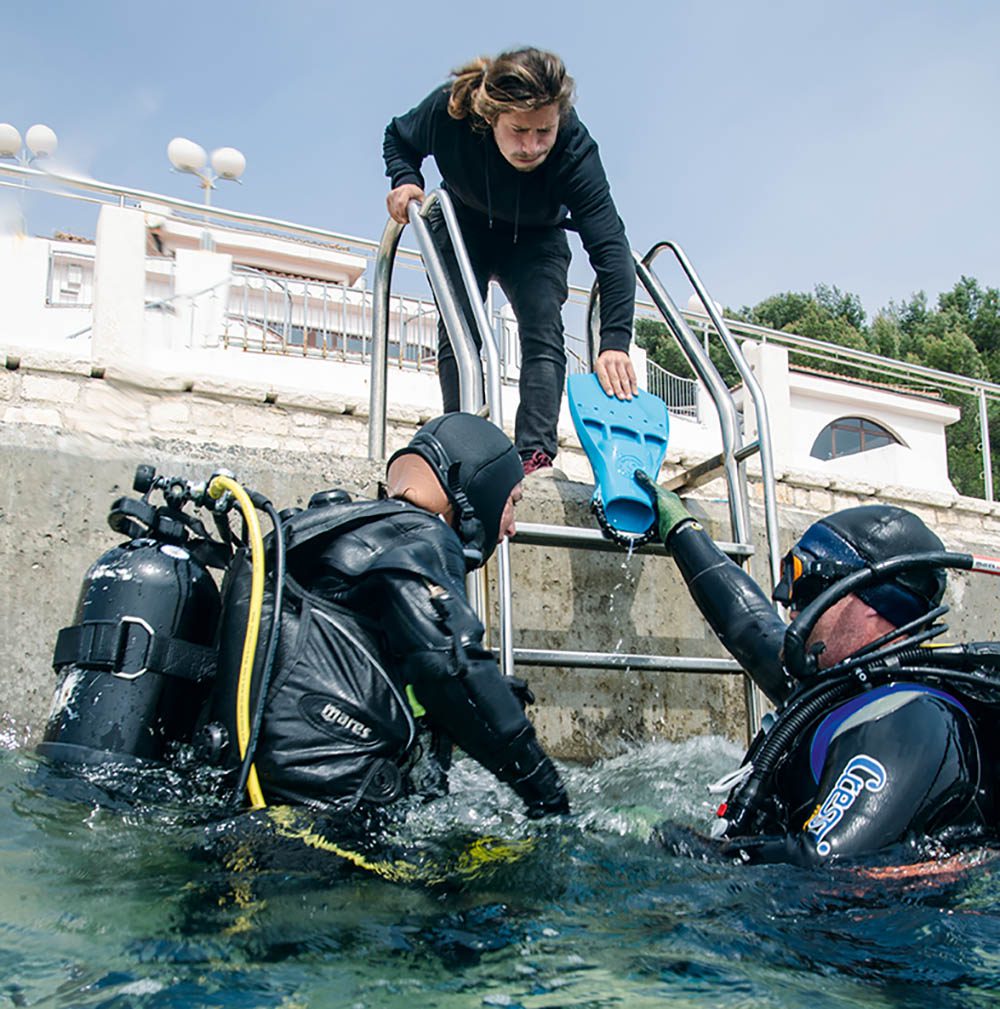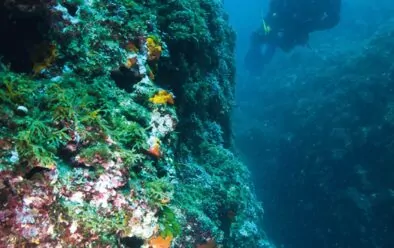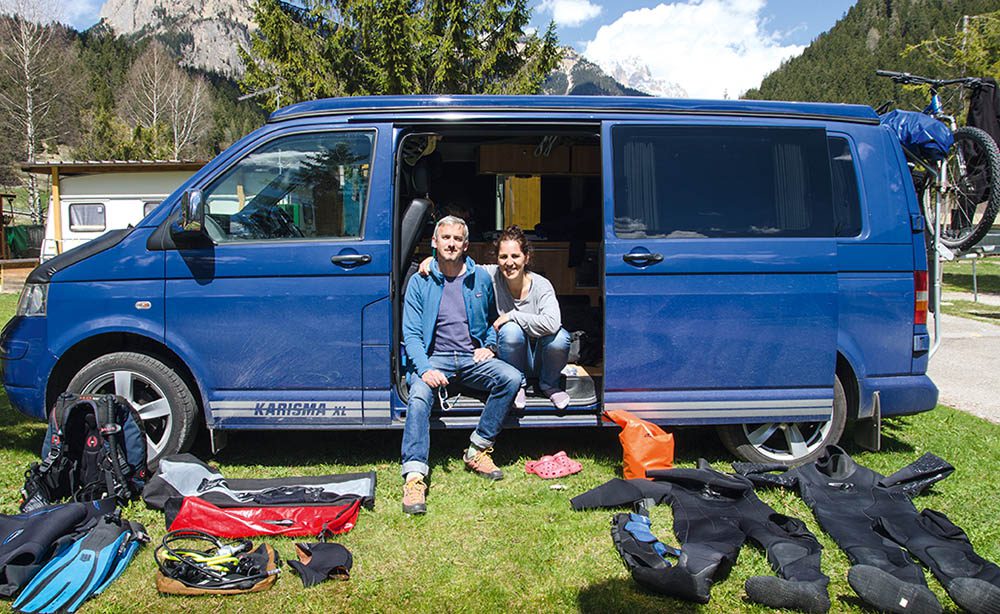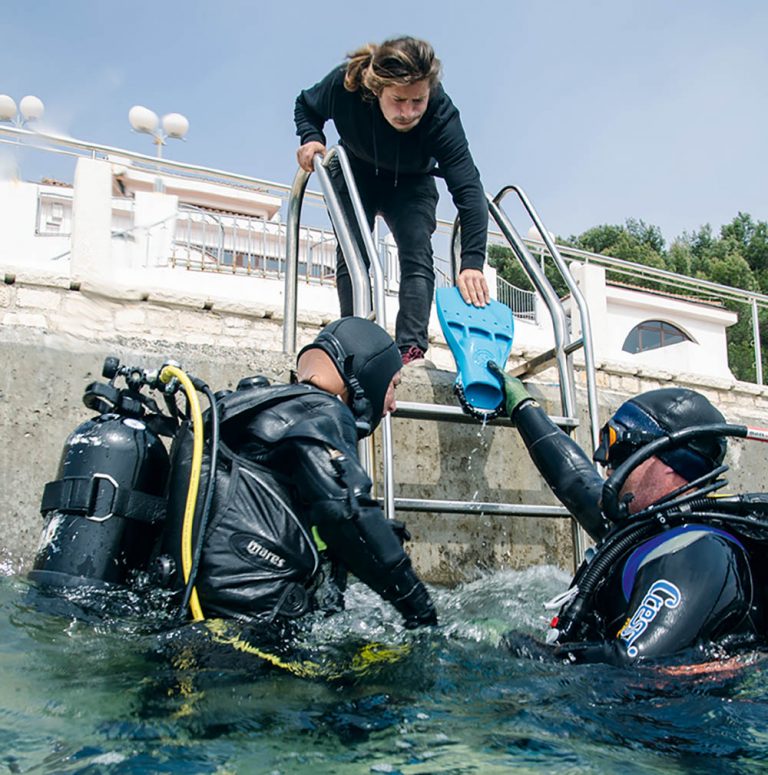CROATIA DIVER
Dry-ish Run
WILL APPLEYARD and his partner Ana undertake a Croatian diving road-trip, though for long periods it looks set to be no more than a Croatian road-trip!

A helping hand after the Pula shore-dive.
I’m not sure which intrusion wakes me first – the banging on our windows, the guttural laughter and shouting outside, or perhaps a terrified Ana shaking me awake to deal with a problem that I hope will eventually deal with itself.
Peering into the night through a gap in our camper-van curtains, I can just about make out the partially lit faces of several men I had seen earlier that evening, hunched over a rapidly growing collection of beer-bottles in a smoky locals’ bar in the village of Muc.
It’s 2am, and I just know that we shouldn’t have “wild-camped” in this street for the night.
Ana and I had talked about Croatia a lot in the past. We had heard only exciting things about the destination above the water-line, though always followed by a “…but Dubrovnik is super-busy during the summer” rider.
Knowing little about the diving on offer, we had decided to check out the country by road during springtime to beat those crowds.
We choose a new cross-Channel route (for
us at least) from Portsmouth to St Malo in northern France, courtesy of Brittany Ferries. Most of this overnight crossing happened while we slept.
With hindsight, landing in Calais or Dieppe would have been better, because we could have avoided the hellish Parisian peripheral road, while also reducing our mileage significantly.
Appeared in DIVER August 2019
We manage to bypass all the pricey French toll roads, easy enough when crossing the top half of the country, which takes us just over a day to knock off.
Germany comes and goes quickly thanks to the slick autobahn, where I don’t dare to venture so much as a tyre in the fast lane.
The traffic flows efficiently at high speeds, cars leapfrogging one another in a well-choreographed routine.
Austria brings snow in the high mountain passes and two very cold nights. We’re relieved to have packed an extra blanket and portable gas-heater at the last minute.
Slovenia offers scenery of unimaginable beauty and pristine wilderness, with hints of Canada and notes of New Zealand.
Rivers the colour of overly processed digital photographs flow through deep valleys rich with greens and yellows. We camp by silent, glassy lakes that beg to be dived.
We clip the shoulder of Italy, stopping only for coffee and to warm our pasty, wintery selves in the sun, as the first signs of spring arrive and temperatures exceed 20°C.
The border crossing into Croatia is slow.
I notice that my right arm has become sunburnt from the drive as we crawl towards passport control.
We enter the northern interior, which after only a couple of hours’ driving reveals scars left by the 1990s Balkans conflict. On wide, flat, mountain-fringed plains sit small agricultural plots dotted with houses, some new, some abandoned or burnt-out and many riddled with bullet-holes.
Croatia’s interior is a confused place in which natural beauty sits beside appalling historical brutality and human suffering.
Our first night in the country is spent, with the owners’ permission, in a restaurant car-park in a sparsely populated country village. We buy a few beers from them.
On day two, with fuzzy heads, we at last reach the magnificent Croatian coast, where mountains dive into the Adriatic and the road winds between them.
What we haven’t realised is how many islands Croatia appears to have collected (1244!) and with such wonderful topography we could be in Indonesia were it not for all the Croatian flags adorning shops and houses.

We have planned a spread of three dive locations: first Dubrovnik in the south, mid-placed Tuçepi and finally Pula, in the north. Before reaching Dubrovnik, we have to cross Bosnia, which owns a sliver of coastline. This means two more border-control checks.
“If I find something in your vehicle that you have failed to declare, you will be taken to prison for seven years, do you understand?” The guard drops his serious spiel on us, demanding that we show him around our cupboards, drawers and diving equipment.
I begin to feel slightly sweaty, look unnecessarily guilty and wonder if we might be carrying too much beer, or whether our many kitchen knives could constitute offensive weapons.
I am starting to imagine life in a Bosnian prison, but eventually our passports are handed back and the guard is wishing us an enjoyable journey.
Croatia for me is a top-five coastal-drive contender, but by the time we reach Dubrovnik, with its cruise-ship port, impressive bridge and red-roofed buildings, we’re ready for some underwater action.
Blue Planet Dive Centre is at the foot of the posh-looking Dubrovnik Palace Hotel, just below the pool and near the rocky shore. Emails exchanged before the trip had seemed friendly and supportive, but communications deteriorate from the moment we walk through the office door.
As the diving was to be reviewed in divEr, it had been made clear in advance that it would be provided free of charge. Blue Planet had changed its mind, however, and insisted on no more than a small discount, claiming that it had divers “queuing out the door all year” and that it “didn’t need the exposure”. Fine, but why not say so before our arrival?
We put ourselves at the back of a line of hotel guests, mostly Americans plus a couple of other Brits, on the morning of our scheduled diving day, ready to fill out the usual PADI paperwork.
Most if not all of us have arrived without logbooks – I rarely travel with one these days.
With all divers present, we notice the centre manager begin to grill everyone in the queue about their diving history, to a level that seems excessive. Ana and I exchange raised eyebrows.
Rather than accepting verbal replies, he continues to interrogate each diver at length, until he finally comes to us.
He seeks further confirmation of Ana’s qualification online, apparently not satisfied by her valid cert card. I dig out PADI certs of my own and these, along with my verbal dive-tally, are eventually accepted but only when I add in my commercial diving certification.
Had we been newly qualified divers, we could well have started our Blue Planet Diving experience on the wrong foot. So, a bad start with the admin, but what else could possibly go wrong?
We have read about several easily accessible wrecks in the area, and mention the possibility of diving them to the staff.
Yet, rather than the 10 guests being split into ability groups, we’re all taken by boat for a whistle-stop underwater tour of the closest site, which is largely featureless but for one swim-through.
Post-dive, we decide that this centre is set up mainly for try-divers and newly qualified guests. Nothing wrong with that, but we have invested many hours on the road into our project, and are keen to explore the best diving that Croatia has to offer.
We decline to take part in dive two. It’s not only us; nobody in the group looks
or sounds particularly inspired by the morning’s diving. Not only that, but from its description the next site sounds similar to the one we have just visited – and there are no wrecks on offer.
We pack our equipment, leave for lunch in Dubrovnik and explore the old city and its impressive walls. With the benefit of hindsight, we should perhaps have checked all the local dive-centres’ online reviews, and considered smaller, more independent centres that might be keener to satisfy our diving requirements.
We favour a campsite for two nights in Dubrovnik over wild-camping. Campsites are plentiful, reasonably priced in low season and there are only so many days we are willing to forego a hot shower.
The city proves delightful if busy, but in spring at least the roads are manageable and the campsites under a quarter full, if not empty.
With time restraints urging us north, we head for Butterfly Diving in the marina village of Tuçepi. A fat band of sea passes between the mainland and a long strip of an island called Brac.
Tuçepi faces the island and we’re eager to submerge once again into the cool, clear Adriatic – perhaps this time with some wreckage to explore?
Sebastian, Butterfly’s welcoming German owner, treats us to morning coffee in the sun by the marina where he keeps his boat. He has lived in Croatia for 14 years and is keen to accommodate us in any way he can – except that he can’t.
Croatian diving suffers from two types of strong wind – the bura from the north or the jugo from the south. When they blow, they can blow out diving completely.
We’re in the unfortunate position of arriving with only a two-day diving window available before we have to head north to Pula.
Both days are going to be blown out by impending howling southerlies. So we decide to hop on the last evening car-ferry to Brac to see if there is any chance of soaking the neoprene on its sheltered side.
Brac is clearly a seasonal destination and, though we’re seeking quieter times in Croatia, almost too quiet for us – the villages are almost empty and/or closed.

A local dive-centre appears keen to help us but is fully booked on day one of our two-day window. On the second day, it too is affected by the wind.
We fall in love with Brac’s cute coves and villages, windy roads and rugged terrain, and particularly enjoy a delicious lamb lunch at Konoba Kopacina provided by the Croatian Tourist Board. The Croatians know how to grill!
We cheat, and an alternative mid-afternoon ferry lands us many miles further up the coast than our inbound journey did, in the city of Split.
This jump knocks a chunk of tarmac time off our journey, giving our workhorse camper van a well-deserved rest. We look skywards as we hit the coastal road once more, praying to the diving gods that Pula will rescue this dry-ish diving adventure.
Warmed to idiocy by wine (to quote the writer Laurie Lee) and our heads roaring with panic (to partially quote him again), we approach our last hope – Orca Diving, in Croatia’s far north.
I always like to locate an unfamiliar dive-centre the day before “ropes off”. Squabbling over directions is the last thing a diving duo needs the morning before a dive, especially when that duo is already squabbled-out from hundreds of miles together on the road.
It still seems windy but Olga, part-owner of the family business, assures us that we will be able to dive, though one day looks better than the other. Orca again sits at the foot of a large hotel, but clearly operates quite independently of it.
The building is Tardis-like, unassuming from the outside yet with a vast interior complete with classroom, welcoming and well-equipped.
Olga introduces us to her son and dive-guide/instructor Marin, who is eager to show us the house reef, the only site accessible if the wind drops enough to allow us out on the boat the following day.
We pull on our drysuits and Marin his 5mm wetsuit – he is clearly made from tougher stuff than us, with the water still only 13 °C in spring. Clarity is reasonable and the beige rock and sand seabed drops gradually to 15m. At this time of year the marine life is just starting to return, though Marin does find us three conger eels during our hour-long dive.
He leads us to a pile of broken Roman amphoras before pointing out a crab wearing a sponge shower cap and eating a starfish beside a small sunken paddleboat.
Although sparse in places, the yellow sponges add a splash of colour. Marin looks into every hole for items of interest to show us, including many nudibranchs.
The remains of an 18th-century ship’s mast appear out of the turquoise, and in places small shoals of fish are present. Marin must have done this dive hundreds of times, yet still has much to enthuse about once we’re out of the water.
We are pumped for diving again, and sense not only great vibes about the dive-centre but Pula as a diving, and indeed city-break, destination.
Campsites are already filling up with motorhomes from every corner of Europe, and we check out a couple before settling into Stoja Camping.
We note that many of the sites, most of which are coastal, have their own dive-centres, but we remain loyal to Orca.
With plenty of wind still about, we make a short swim out to Orca’s hardboat to spare its hull from the concrete jetty. Marin is taking the two of us to one of his favourite sites, Fraskeric.
Four beautiful caverns start at just 3m and eventually take us to a maximum depth or around 20m. “Rays of light break through holes in the ceiling of the shallow tunnels at certain times of day, and this can be a spectacular sight,” he tells us.
The location is also known for its free- and night-diving and seahorses, we hear.
Boat travel time is minimal, and we arrive kitted up. Currents are no problem as we follow marin to the seabed.
I’m a sucker for a cavern dive and it feels great to be embarking on some underwater exploration after so many disappointments. One by one we discover the caverns, some appearing as gaping black holes on initial entry, with a hue of blue appearing at the exit-point once our eyes have adjusted.
Some entrances and exits are narrower than others, with the tunnel requiring a vis-killing wriggle between rock and sand at the seabed.
This is in no way a “cave dive”, but it’s an exciting one for a recreational diver. We eke out an hour of exploration before the cold creeps in and air consumption sends us skywards for the last time in Croatia. Orca Diving has saved our drive-and-dive adventure with this epic final immersion.
We learnt a lot in Croatia. We learnt the importance of digesting online company reviews prior to a visit; the need to allow ourselves plenty of contingency time; and not to sleep in a van outside bars full of drunken locals.
FACTFILE
GETTING THERE> Brittany Ferries Portsmouth-St Malo, brittany-ferries.co.uk
DIVING> Orca, Pula, orcadiving.hr, Blue Planet, Dubrovnik, blueplanet-diving.hr
ACCOMMODATION> Arena Campsites, Pula, arenacampsites.com; Solitude Camping, Dubrovnik, camping-adriatic.com
 WHEN TO GO> The winds are unpredictable at any time of year in Croatia, so spring is still a good bet to avoid the summer crowds.
WHEN TO GO> The winds are unpredictable at any time of year in Croatia, so spring is still a good bet to avoid the summer crowds.
MONEY> Croatian kuna.
PRICES> Fuel for 2900-mile drive from Brighton to Dubrovnik via Pula around £600. Channel ferries return with cabin £570. Split-Brac ferries £19-35 each way (depends on vehicle). Camping £15-30 a night for two. Orca two boat-dives 56-116 euros. Blue Planet 10-dive pack 286 euros.
VISITOR Information> croatia.hr, istria.hr, dalmatia.hr, tzdubrovnik.hr

